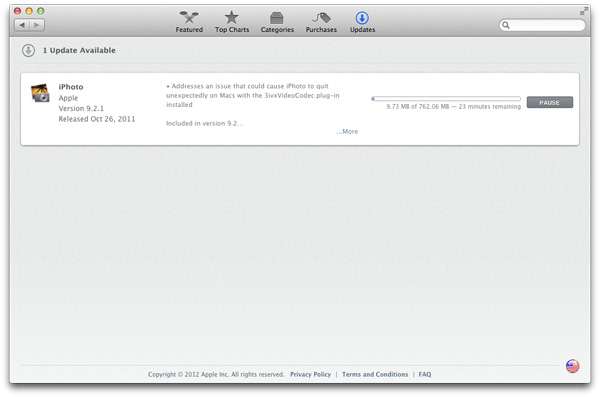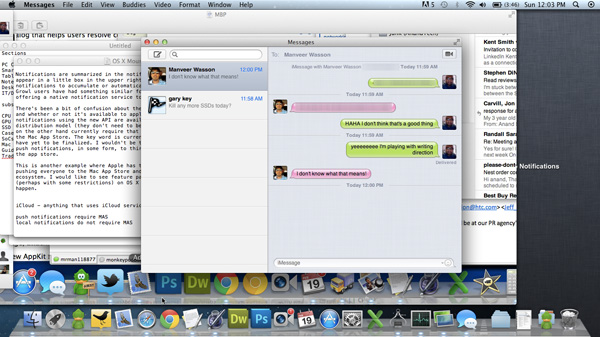Thoughts on the Mac OS X Mountain Lion Developer Preview
by Andrew Cunningham & Anand Lal Shimpi on February 19, 2012 7:40 PM EST- Posted in
- Mountain Lion
- Mac
- macOS
Software Updates & Moving Toward the Mac App Store
To be honest, I rarely use the Mac App Store. I appreciate it because it does let me quickly get Apple applications without fumbling for a restore DVD somewhere, but otherwise I get all of my non-Apple apps directly from the source. The app store makes sense to me on iOS because that's the only option we were presented with from the start, but even there I would appreciate the flexibility of installing apps from any source. On a Mac the opposite is true. Just as was the case on PCs, I've always grabbed and installed software on my Macs from a multitude of sources and I've never really wished there was a centralized, policed repository of Mac applications. That being said, I do understand and accept that I may be a part of a shrinking minority. Apple's most successful products have been those sold effectively as appliances. The MacBook Air took many steps in the same direction by offering no end user upgradeable CPU, memory, storage or battery options. With the MBA you're buying some sort of a Mac appliance hybrid. It's a good device (I'm typing this article on an MBA now), but in many ways it's an inflexible one.
My fear is that as Apple straddles this line between the old and the new, that it will step over too far into the walled garden/appliance territory. That OS X, just like iOS, will become a platform powered only by the app store. That isn't the reality today and I hope that it never will be, but the temptation is surely there. Apple gets a cut of all software sales through the Mac app store, it doesn't elsewhere. App stores are a way of continuing to profit off of a platform after you've sold the initial hardware and operating system. From a customer experience standpoint there's also significant motivation behind supporting only a centralized app store. With complete control of what can run on the platform, Apple could guarantee and maintain the level of experience that it's always been in pursuit of.
Again, today, this isn't a problem but there's definitely movement in that direction. Mountain Lion does away with Lion's Software Update mechanism and instead integrates that into the Mac App Store directly.

There's no change in functionality, just a change in physical location. I will admit that the software update tool always felt like it needed...updating, but I don't know that I would've put it in the MAS application.

Remember all of the new APIs that developers now have access to? A couple of them are only available to applications distributed via the Mac App Store. The big one is iCloud. Any application that interfaces with or uses iCloud is required to be in the MAS. It's the tradeoff you make when you start using Apple's cloud storage as a selling feature of your application. There are ways around this requirement (you could decouple any cloud storage features from your main application and simply offer the former through the app store) but it's a bifurcation of the Mac software feature set for the most part.
The notification story is a little different.
New Notifications API & Interface
Revamping notifications was a major part of the iOS 5 update last year and Apple decided to bring some of that to OS X. Mountain Lion sports a new iPad-like notification center that's accessible by performing a right to left, two finger swipe on a multitouch trackpad. The gesture is unique in that it's the first gesture that must be started at the very edge of the trackpad. A two finger right-left swipe starting in the middle or even an inch from the border of the trackpad is different entirely. To bring up the notifications menu you have to start the gesture at the very edge of the trackpad. It's easier to just start swiping off of the trackpad first, allowing the gesture to then continue onto the trackpad surface. The notification center gesture is very reminiscent of the PlayBook/webOS bezel gestures that have similar requirements for starting outside or at the beginning of the touch area.

Notifications are summarized in the notification center but as they happen they appear in a little box in the upper right of your screen. You can configure notifications to accumulate or automatically disappear after a short period of time. Growl users have had something similar for a while now, but Apple is now officially offering a native notification service to all developers.
There's been a bit of confusion about the new notifications API (NSUserNotification) and whether or not it's available to applications not in the Mac App Store. Local notifications using the new API are available to third party apps regardless of their distribution model (they don't need to be in the Mac App Store). Push notifications on the other hand currently require that the application is distributed only through the Mac App Store. The key word is currently because a lot of Mountain Lion decisions have yet to be finalized. I wouldn't be too surprised if Apple decides to open up push notifications, in some form, to third party applications not distributed through the app store.
This is another example where Apple has to carefully straddle the line between pushing everyone to the Mac App Store and not abandoning the rest of the Mac software ecosystem. I would like to see feature parity regardless of distribution model (perhaps with some restrictions) on OS X going forward, but I'm not sure that will happen.










96 Comments
View All Comments
solipsism - Sunday, February 19, 2012 - link
AT has plenty of articles about Win8.• http://www.anandtech.com/tag/windows-8
Keep in mind that Win8 was leaked, in pieces over a long time so AT had to mostly write blog-length statements about many of the new features as they dropped, while Apple dropped an entire OS update at once with a detailed webpage and reviews by famous journalists and bloggers who got a one-one-one.
ananduser - Monday, February 20, 2012 - link
Anand is a mac user nowadays. Of course he tends to give more attention to mac wares and mac software. That doesn't mean he ignores other platforms or is less fair.solinear - Tuesday, February 21, 2012 - link
Honestly, I couldn't disagree more. There is a huge amount of attention paid to every Apple product here now, almost like it's a "zealot lite" website. I love how they focused on the amazing improvements in the browser, talking about how the tabs worked and scaled now... I'm sorry, but I haven't seen a browser where the tabs didn't scale automatically as you opened more in ages, but Apple is the 'standard' that they compare everything else to?As a result, I tend to find myself going to the hardware (SSD mostly) reviews and ignoring a lot of the others. I might be largely alone, but I see a very heavy amount of coverage to the Apple products, particularly for their market share. If he's going to review Apple stuff all the time, maybe he should be reviewing various Linux distro GUI changes and so forth, if he wants to be fair. I can only remember one of those and it was a LONG time ago.
repoman27 - Wednesday, February 22, 2012 - link
If you're not interested in reading articles about Apple products, simply ignore them. If you want AnandTech to focus more on topics of interest to you, just ask, they seem pretty receptive to input.If Apple articles get a significant number of page views and generate decent revenue for the site, why should AnandTech stop posting them? Just because you're not interested in this type of content doesn't mean that other readers aren't. (Apple now has greater than 10% of US marketshare, and their customer base tends to be of a demographic group that is quite desirable to advertisers.)
KPOM - Monday, February 20, 2012 - link
I doubt it. If anything, iOS 6 would be more of the response to Windows 8 than Mountain Lion. The Mac is an important part of Apple, but it represents only 25% of its revenue. iOS represents about 50% of its revenue and about 70% of its profits.Apple always has had a faster release cycle for OS X than Microsoft had for Windows. Plus, they have for quite a while dropped support for older Macs and/or software with each new release. Leopard dropped the Classic mode. Snow Leopard dropped PowerPC. Lion dropped Rosetta and 32-bit Macs. Apple, unlike Microsoft, makes its money on hardware rather than software, and thus does not have an incentive to keep its new operating systems running on ancient hardware the way Microsoft does.
MonkeyPaw - Sunday, February 19, 2012 - link
"The last thing I wanted to talk about is something we've already touched on, but it bears repeating - Mountain Lion is dropping support for any Mac that is not capable of booting OS X's 32-bit kernel."Am I understanding that right, or should that read "64-bit kernel"?
jedivulcan - Sunday, February 19, 2012 - link
From what I've been reading and seeing elsewhere on the internet, AirPlay Mirroring does using the latest iOS 5 beta for Apple TV and a Sandy Bridge based Mac.solipsism - Sunday, February 19, 2012 - link
I'm not a fan of LaunchPad but it's perfect for those that aren't heavy or proficient computer users. It makes finding and executing an app simple while bringing a familiarity seen on iOS-based iDevices which far outnumber Macs.PS: Dashboard also gets the Launchpad-like displaying of widgets and it's much better than their previous model of having a single row at the bottom that scrolls off screen.
ltcommanderdata - Sunday, February 19, 2012 - link
Any word on new OpenCL (1.2) or OpenGL (4.x) support?With no QuickSync instead relying on CPUs, hopefully they at least are implementing extensive SSE4.x and AVX acceleration.
ananduser - Monday, February 20, 2012 - link
Apple is not really famous for up to date graphical driver support. And in a way I tend to side with them. The most recent OpenGL implementations are only needed for games and not for CAD.